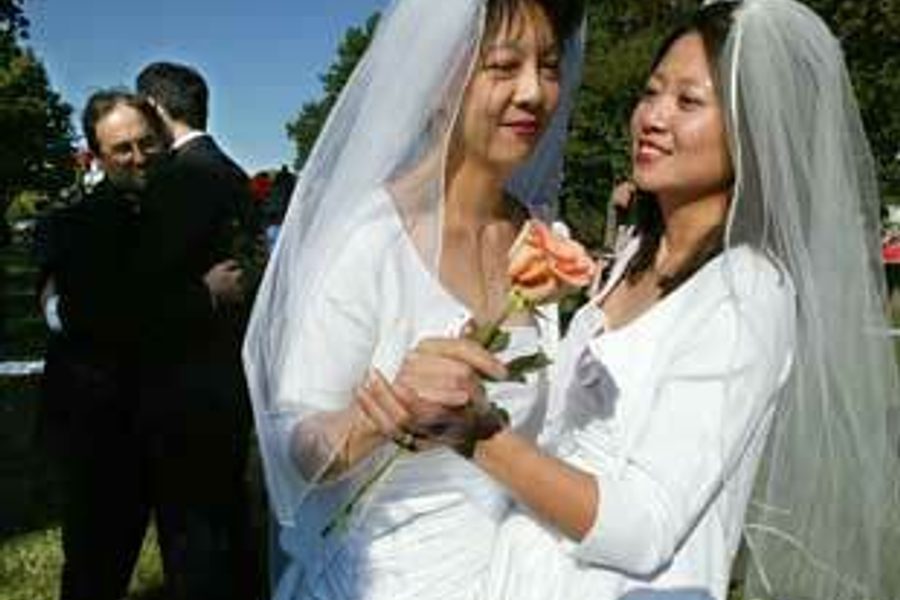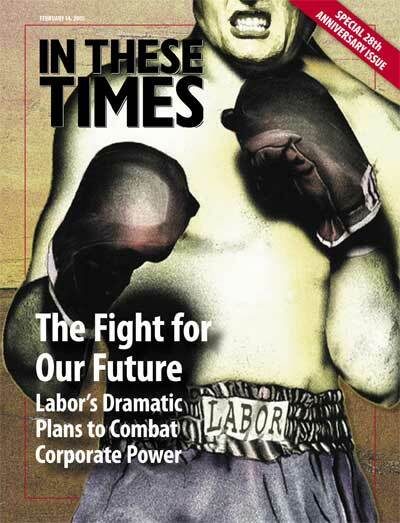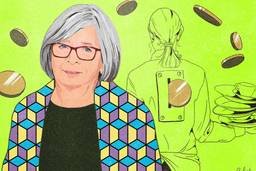
The election was bad enough; the hand-wringing is almost worse. Democrats are in a fugue, strategizing ways to be more conspicuous churchgoers, while radical types talk bravely about moving to Canada. The feeling is particularly acute among queers (on whom pundits started blaming the Republican victory months before it even happened). Plenty are wondering whether the lesbian, gay, bisexual, and transgender movement pushed for same-sex marriage too fast, before the country was ready, including the most prominent mainstream gay lobbying group, the Human Rights Campaign (HRC). It recently asked for the resignation of its executive director and said it would adapt its tactics to be more low-key. (Curious, since HRC’s tactics don’t exactly include lying down in the street.)
For queers, marriage seemed for so long both an unglamorous, assimilationist goal and an utter fantasy. Now, judging from the reactions it provokes, it seems radical and, perhaps, imminent. How did this happen? A recent book by historian George Chauncey attempts to put the debate in perspective historically. Why Marriage? draws on Chauncey’s pathbreaking first book, Gay New York, as well as his work writing the Historians’ Amicus Brief in the 2003 Supreme Court case Lawrence v. Texas, which overturned the nation’s sodomy laws and was part of the reasoning behind the Massachusetts’ court decision to allow same-sex marriage. Same-sex marriage, he maintains, has been floated as a possibility by successive generations of queers, from a variety of political standpoints. A kind of “marriage” had always existed informally whenever partners lived together and were recognized by the community as a couple. (This, not church-sanctioned nuptials, was the “ancient” form of marriage.) What brought it to the fore in the ’80s was AIDS and the so-called lesbian baby boom — in other words, death and children. You could say this raised the stakes somewhat.
These experiences made gays and lesbians realize the ways in which the lack of legal recognition of their relationships interfered with some of the most intimate aspects of their lives — the ability to care for a sick partner, for instance, or the bonds between parents and children. Those with exceptional foresight and enough money learned how to navigate the bureaucratic nightmare of powers of attorney and other sorts of legal documentation. “A full set of the documents necessary to approximate the protections provided by marriage could cost several thousand dollars,” Chauncey writes, “a marriage license might cost $25. … And given the expense of other legal documents, marriage was the only way many poorer couples could afford such protections at all.”
But the point of Chauncey’s book is not to make the case for gay marriage; it’s to provide historical background on the debate — which is sorely needed, since much of the contemporary animus against homsexuality presumes that such bias is upheld by centuries of precedent, especially religious precedent. But the belief that religion never changes is mistaken, Chauncey writes. Only 50 years ago, many white southerners were taught “segregationist theology”: that the Bible showed God was against race mixing. He put the races of humankind on separate continents to prevent it. He sent the floods in Noah’s time to stop it, and later destroyed Sodom and Gomorrah for the same reason. Some were even taught that the serpent in the Garden of Eden was actually a black man.
These were mainstream ideas, once; today they are disavowed by most of the Christian right, including Jerry Falwell, who in the ’50s condemned school desegregation as against God’s plan. What are thought to be “ancient prejudices” are open to revision. This kind of argument devastated sodomy laws in Lawrence; it may do the same for marriage laws.
Another popular misperception that Chauncey explores is that marriage is a religious matter. “The religious argument against same-sex marriage ignores a fundamental historical fact about marriage in the United States: It has always been a civil matter.” The state issues a marriage license; a church may or may not choose to bless the union. “The rules established by many churches restricting who may marry whom in a religious ceremony have not, in fact, been able to prevent people from getting married.” In the eyes of the state, a couple married by the Catholic church, say, would be just as married if they had had a properly credentialed Elvis impersonator preside at their wedding. This arrangement also allows different religions — and different denominations within religions — to maintain their own rules regarding marriage. This arrangement is called religious freedom.
Chauncey also clarifies the limits of marriage — it’s not synonymous with equality, as some of its proponents believe — and acknowledges that some in the gay community are wary of marriage, if not outright against it. Those attitudes are represented in the raucous anthology That’s Revolting! Queer Strategies for Resisting Assimilation, which dares ask whether the LGBT movement can include social justice goals such as universal health care, housing, the protection of civil liberties, the rights of immigrants and youth services. Contributors include community organizers, punks, artists, anarchists, sex workers and students. The focus is on activism; there’s no queer theory. The tone is fierce and funny, inspired as much by the spirit of Seattle as Stonewall.
Only a few of the pieces in That’s Revolting! deal specifically with marriage; the writers train their sights on something more ambitious: assimilation into the mainstream. As editor Mattilda explains in the introduction, this has enabled some gays and lesbians to live complacently ensconced in gentrified urban enclaves, where they fight like hell to maintain the boundaries of their privilege: “Gay landlords evict people with AIDS to increase property values; gay bar owners arrest homeless queers so they don’t get in the way of business; and gay political consultants ensure the election of pro-development, anti-poor candidates who ensure that the ruling class not only remains in power but systematically sucks the poor dry.”
This argument assumes that in the past gays and lesbians were more radical critics of mainstream American culture. It’s hard to prove something like this, and the writers in this collection don’t pretend to try to. But it does seem true, especially since the ebbing of AIDS activism among white gay men after the introduction of antiretroviral drugs in the mid-90s. The election of Bill Clinton also seemed to gradually sap much of the community’s adversarial attitude. In addition, the fight for universal health care, so central to the discourse of AIDS activism, seemed virtually abandoned after Clinton’s modest proposals went down in flames in 1994.
Yet radicals did persist. That’s Revolting! reads like a patchwork alternative history of the gay ’90s and 2000s: the part queers played in the anti-globalization movement, their responses to racist “quality of life” policing, how they coped with welfare reform and the withering of social services and their valiant efforts to banish tacky corporate sponsorship from gay pride parades. The essays and interviews generally show a sophisticated understanding of how such impersonal forces as economics affect life on the ground for ordinary members of the LGBT community. It’s ironic that they denounce assimilation at the same time that they demonstrate the web of ties between the community and the larger world, and forge connections across boundaries of race, ethnicity, gender identity and class.
It’s also ironic that part of resisting assimilation has to be essentially conservative — that is, preserving gay culture as it is. Forget for a moment that this is impossible, that gay culture, like everything else, is subject to the forces of time. Forget too that it was created as a refuge against oppression. The radical heritage of gay culture is real, and it is worth preserving to whatever extent possible.
But this isn’t really the kind of strategy That’s Revolting! offers. Assimilation seems to boil down to individual actions and personal decisions: working a corporate job, having kids, buying Diesel jeans, appearing in a sitcom; it’s not dealt with as a demographic inevitability of millions of people coming out over the past thirty years, a relatively brief period of time historically speaking. The more people who come out, the less “alternative” the lifestyle becomes. If your family accepts you as gay, you are less likely to experience the degradation in living conditions you would likely suffer were they to, say, kick you out of the house. If your employer has a nondiscrimination policy, you may never experience the fear of being fired if anyone at work finds out you’re gay. And if you do not have to give up any class privileges to be openly gay, you may not think you have anything in common with those who do.
Chauncey suggests another way of seeing assimilation, based on recent theories of ethnicity, which “recognize that even as immigrants were reshaped by their incorporation into American culture, so too was American culture.” As annoying as the marriage movement can be — its squeaky-clean poster children, its romantic sentimentality, its denial of genderqueers — the process of trying to change marriage laws is having a radical impact on American society. Although the aspect of heterosexual privilege that marriage advocates target is extremely specific, it is also profoundly consequential. It is perhaps the most obvious boundary separating straight from queer, and as such is taken by many as a profound threat to heterosexual identity. Yet marriage advocates didn’t start this process; challenges to heterosexual privilege have been driven for the past 30 years by those willing to put their bodies on the line to fight homophobia and trans-phobia. And they’re not going away.





